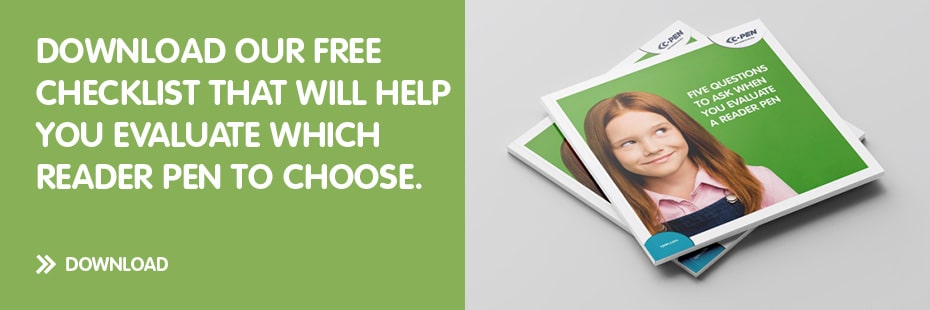
What online and offline capabilities do you need in a reader pen?
There are two ways a reader pen can work. It can be a stand-alone with all functionalities embedded in the pen, or it can be a connected device that uses a computer or a smartphone to process the information via Bluetooth or a USB. Which suits your needs best is a question of mobility, price, and functionality. Depending on the workflow, both types of pens can do the same job but are more or less optimal. If your students only use the reader pen in the classroom, there is no disadvantage to using a wired USB connection. If they need to be more flexible but still only are feeding text into a computer, then a wireless connection is better. And if they use it mainly as a reading aid and don’t want to handle two different devices., the stand-alone reader pen is the best choice.

A connected reader pen is suitable for continuous scanning
A connected reader pen will be sufficient if your students mostly scan text directly into a computer for further editing. Whether you choose a wired or wireless connection depends on the situation. If the reader pen has a wired connection, the students only can use it when they are sitting at the computer. A wireless Bluetooth connection is more flexible, enabling them to also use the reader pen with a tablet or a smartphone.
When choosing between a wired or wireless device, there is also an efficiency aspect. A reader pen with a wired USB connection is always online, whereas a pen with a Bluetooth connection turns off to save energy after a while. So, if you don’t scan continuously, there is a risk that the Bluetooth-connected pen needs to be restarted, which can affect the students’ workflow and distract them. That’s why C-Pen has an underlying functionality that optimizes power management. Setting a short standby period and a long auto-off period can avoid the problem because it’s much faster to go from standby mode than restarting the device, which can take up to 20 seconds.

A stand-alone reader pen is suitable for reading
If you plan to let your students use the scanning pen mainly as a reading aid, it’s often quite unpractical if they must connect to a computer or a tablet. In that case, it’s better to have all functionality embedded in the device itself. It also becomes more seamlessly integrated into the students’ workflow. If your students get stuck on a word, they can scan it, hear it read out, glance at the display to see the definition, and then continue to read in an uninterrupted flow. If they must pick up their smartphone, unlock it, and read the text on the screen, they risk losing focus. Not to mention the risk of being distracted by their phone. With everything embedded, there isn’t anything that can interfere with their reading. They look, listen, draw their pen – it’s all very tactile, and the different sensory impressions will strengthen one another, making it easier for them to remember what they read. A stand-alone reading pen is independent of any connection, and your students can use it in school, at home or even on the school bus. There is no distraction and no dependence on an embedded solution, which is two decisive factors when considering using it for reading.
Benefits of a stand-alone device vs a connected device
A stand-alone reader pen doesn’t need any type of connection to work, and everything is embedded in the device, making it flexible and easy to use regardless of location. Because it is less dependent on connectivity, it’s also more reliable and minimises the risk of not working as intended. A stand-alone reader pen can also be used as a reading aid at exams where students can only use devices with no means of connection.
On the other hand, a connected reader pen is often less expensive than the stand-alone variant because there is no need for internal memory storage or a large display on the device. Instead, it manages much of the functionality via the computer or smartphone. Using a connected device can be limiting, but on the other hand, it’s an affordable solution that gives more people the opportunity to benefit from the aid a reading pen can provide.


